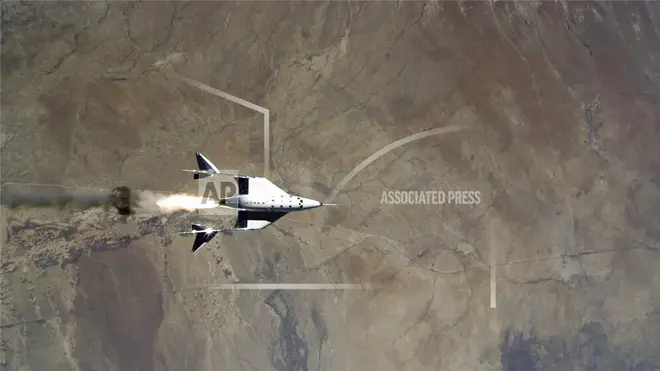
Lewis Goodall 10am - 12pm
22 May 2021, 22:34

Sir Richard Branson said that the two pilots and a research payload belonging to Nasa had reached space.
A Virgin Galactic manned shuttle has made a rocket-powered flight from New Mexico to the fringe of space.
The VSS Unity’s rocket motor sent the ship and two pilots toward space as the company moves towards offering tourist flights to the edge of the Earth’s atmosphere.
A live feed by NASASpaceFlight.com showed the rocket ship accelerating upward, estimated a top altitude of at least 50 miles and confirmed a landing later via radar.
Virgin Galactic founder Sir Richard Branson confirmed in a Twitter post that the two pilots and a research payload belonging to Nasa had reached space.
Delighted to be on the flightline to watch @VirginGalactic ’s first human spaceflight from the majestic Spaceport America @Spaceport_NM #UNITY21 pic.twitter.com/FcpCxJcjqS
— Richard Branson (@richardbranson) May 22, 2021
“Today was just an incredible step in the right direction,” Sir Richard told The Associated Press shortly after the flight landings. “It tested a lot of new systems that the teams have been building and they all worked.”
Virgin Galactic CEO Michael Colglazier said at least two more test flights lie ahead — the next with four mission specialist passengers in the cabin.
“The flight today was elegant, beautiful,” Mr Colglazier said. “We’re going to analyse all the data that we gather on these flights, but watching from the ground and speaking with our pilots, it was magnificent. So now it’s time for us to do this again.”
The company is aiming for commercial operations to begin next year following testing and a few months of down time for maintenance and other upgrades.
That testing will include a flight that will take Sir Richard to the edge of space later this year.
The first powered test in New Mexico from Spaceport America was delayed repeatedly before Saturday’s launch.
In December 2020, computer trouble caused by electromagnetic interference prevented the spaceship’s rocket from firing properly.
Instead of soaring toward space, the ship and its two pilots were forced to make an immediate landing.
While Virgin Galactic’s stock price ticked up this week with the announcement of the latest test being scheduled for Saturday, it was not enough to overcome the losses seen since a peak in February.

Some analysts have cautioned that it could be a while before the company sees profits as the exact start of commercial operations is still up in the air.
Virgin Galactic is one of a few companies looking to cash in on customers with an interest in space.
Elon Musk’s SpaceX will launch a billionaire and his sweepstakes winners in September. That should be followed in January 2022 by a flight by three businessmen to the International Space Station.
Jeff Bezos’s Blue Origin launched a new capsule in January as part of testing as it aims to get its programme for tourists, scientists and professional astronauts off the ground.
It is planning for lift-off of its first crewed flight on July 20, the date of the Apollo 11 moon landing.
Virgin Galactic has reached space twice before – the first time was from California in December 2018. The company marked its second successful glide flight over Spaceport America last June.
Preparations for the latest attempt included a maintenance review of the special carrier plane that flies the six-passenger spacecraft to a high altitude, where it is released so it can fire its rocket motor and make the final push to space.
The flights are designed to reach an altitude of at least 50 miles before the rocket motor is turned off and the crew prepares to re-enter the atmosphere and glide to a landing.
As part of the return trip, a feathering system slows and stabilises the craft as it re-enters the atmosphere.